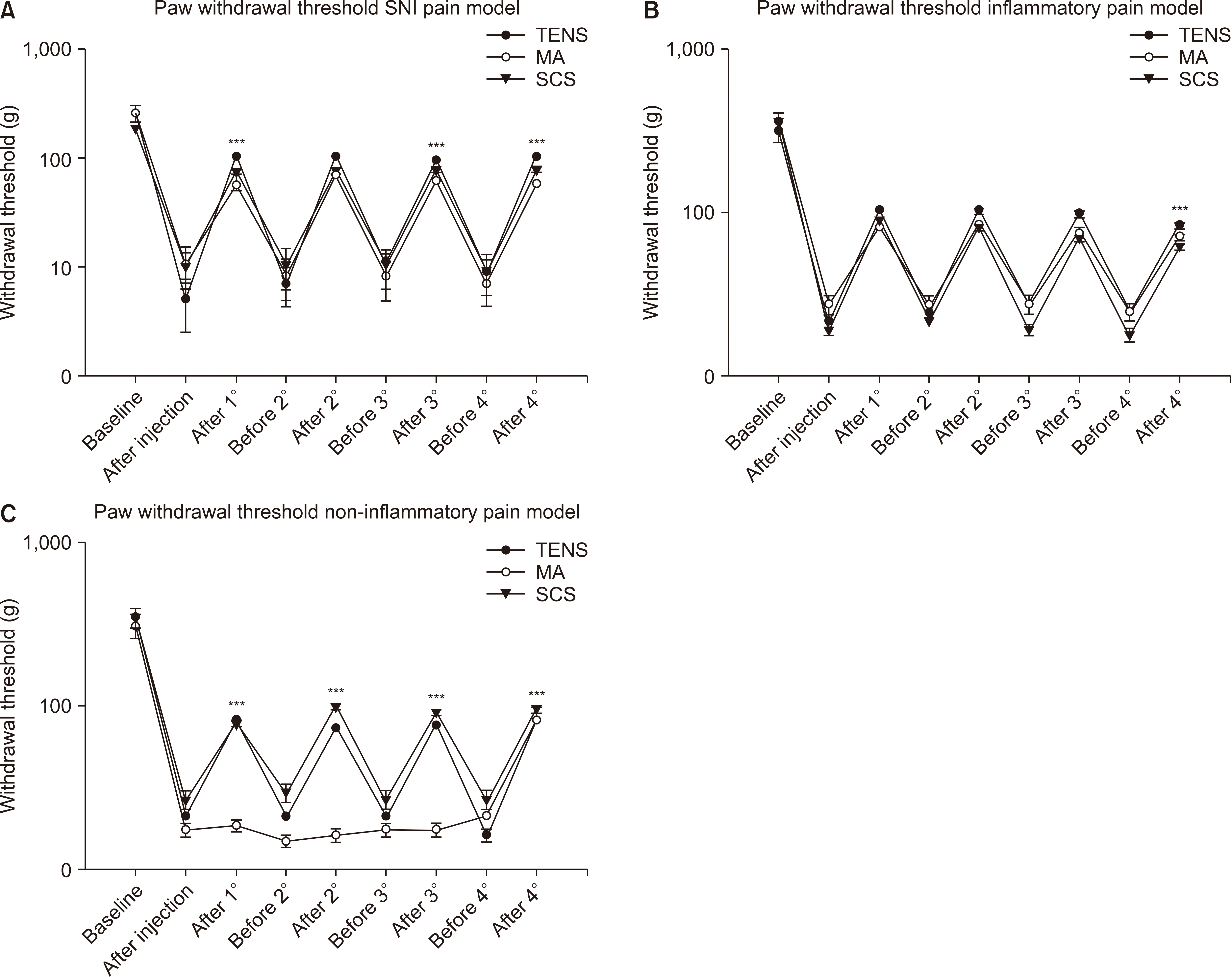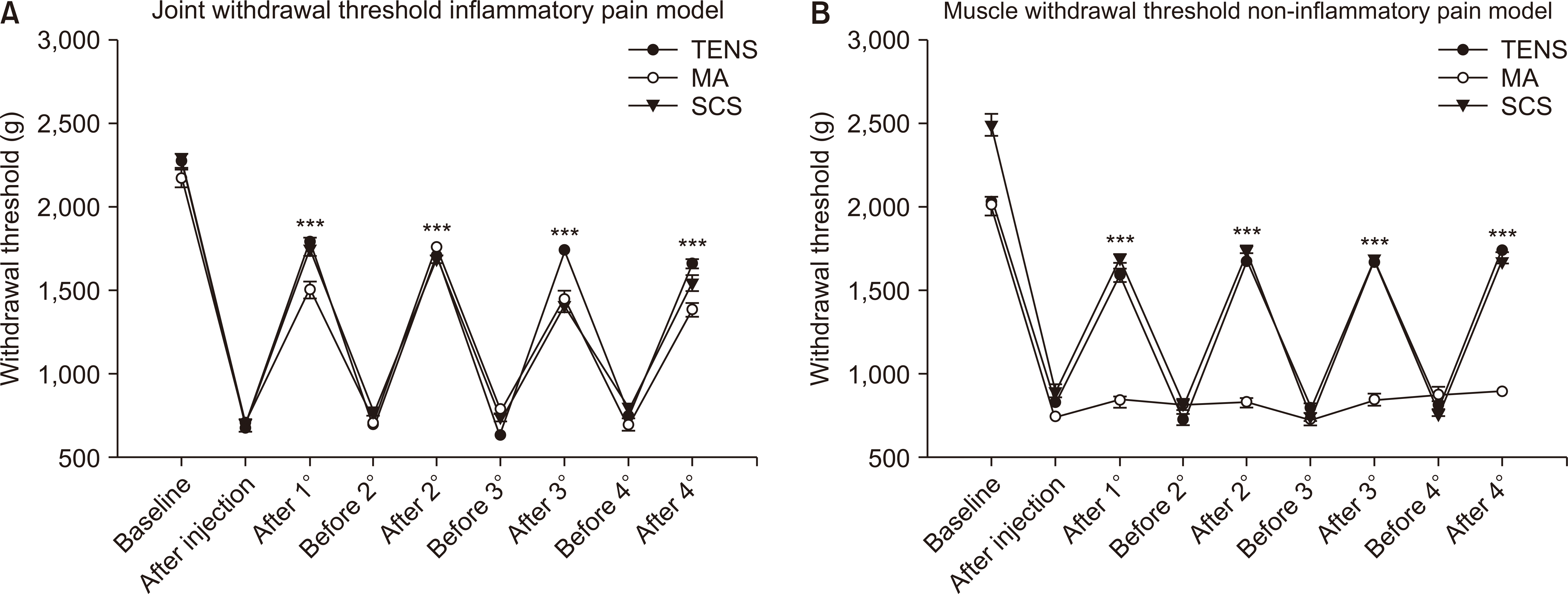1. Orr PM, Shank BC, Black AC. 2017; The role of pain classification systems in pain management. Crit Care Nurs Clin North Am. 29:407–18. DOI:
10.1016/j.cnc.2017.08.002. PMID:
29107304.

3. Radhakrishnan R, Moore SA, Sluka KA. 2003; Unilateral carrageenan injection into muscle or joint induces chronic bilateral hyperalgesia in rats. Pain. 104:567–77. DOI:
10.1016/S0304-3959(03)00114-3. PMID:
12927629. PMCID:
PMC2732018.

5. Lee JB, Choi SS, Ahn EH, Hahm KD, Suh JH, Leem JG, et al. 2010; Effect of perioperative perineural injection of dexamethasone and bupivacaine on a rat spared nerve injury model. Korean J Pain. 23:166–71. DOI:
10.3344/kjp.2010.23.3.166. PMID:
20830261. PMCID:
PMC2935977.

6. Radhakrishnan R, Bement MK, Skyba D, Sluka KA, Kehl LJ. 2004; Models of muscle pain: carrageenan model and acidic saline model. Curr Protoc Pharmacol. 25:5.35.1–28. DOI:
10.1002/0471141755.ph0535s25. PMID:
22294122.

7. Dailey DL, Rakel BA, Vance CG, Liebano RE, Amrit AS, Bush HM, et al. 2013; Transcutaneous electrical nerve stimulation reduces pain, fatigue and hyperalgesia while restoring central inhibition in primary fibromyalgia. Pain. 154:2554–62. DOI:
10.1016/j.pain.2013.07.043. PMID:
23900134. PMCID:
PMC3972497.

8. Beyaz SG, Bal NŞ. 2017; Spinal cord stimulation for a patient with neuropathic pain related to congenital syringomyelia. Korean J Pain. 30:229–30. DOI:
10.3344/kjp.2017.30.3.229. PMID:
28757924. PMCID:
PMC5532531.

9. Lee SJ, Yoo YM, You JA, Shin SW, Kim TK, Abdi S, et al. 2019; Successful removal of permanent spinal cord stimulators in patients with complex regional pain syndrome after complete relief of pain. Korean J Pain. 32:47–50. DOI:
10.3344/kjp.2019.32.1.47. PMID:
30671203. PMCID:
PMC6333578.

10. Sato KL, Johanek LM, Sanada LS, Sluka KA. 2014; Spinal cord stimulation (SCS) improves decreased physical activity induced by nerve injury. Behav Neurosci. 128:625–32. DOI:
10.1037/bne0000004. PMID:
24911318.

12. Cidral-Filho FJ, da Silva MD, Moré AO, Córdova MM, Werner MF, Santos AR. 2011; Manual acupuncture inhibits mechanical hypersensitivity induced by spinal nerve ligation in rats. Neuroscience. 193:370–6. DOI:
10.1016/j.neuroscience.2011.07.076. PMID:
21835228.

13. Kalra A, Urban MO, Sluka KA. 2001; Blockade of opioid receptors in rostral ventral medulla prevents antihyperalgesia produced by transcutaneous electrical nerve stimulation (TENS). J Pharmacol Exp Ther. 298:257–63. PMID:
11408550.
14. Maeda Y, Lisi TL, Vance CG, Sluka KA. 2007; Release of GABA and activation of GABA(A) in the spinal cord mediates the effects of TENS in rats. Brain Res. 1136:43–50. DOI:
10.1016/j.brainres.2006.11.061. PMID:
17234163. PMCID:
PMC2746639.

15. Song Z, Ansah OB, Meyerson BA, Pertovaara A, Linderoth B. 2013; Exploration of supraspinal mechanisms in effects of spinal cord stimulation: role of the locus coeruleus. Neuroscience. 253:426–34. DOI:
10.1016/j.neuroscience.2013.09.006. PMID:
24036376.

16. Takeshige C, Sato T, Mera T, Hisamitsu T, Fang J. 1992; Descending pain inhibitory system involved in acupuncture analgesia. Brain Res Bull. 29:617–34. DOI:
10.1016/0361-9230(92)90131-G. PMID:
1422859.

19. da Silva MD, Bobinski F, Sato KL, Kolker SJ, Sluka KA, Santos AR. 2015; IL-10 cytokine released from M2 macrophages is crucial for analgesic and anti-inflammatory effects of acupuncture in a model of inflammatory muscle pain. Mol Neurobiol. 51:19–31. DOI:
10.1007/s12035-014-8790-x. PMID:
24961568. PMCID:
PMC4276737.

20. Chaplan SR, Bach FW, Pogrel JW, Chung JM, Yaksh TL. 1994; Quantitative assessment of tactile allodynia in the rat paw. J Neurosci Methods. 53:55–63. DOI:
10.1016/0165-0270(94)90144-9. PMID:
7990513.

21. Sluka KA. 1998; Blockade of N- and P/Q-type calcium channels reduces the secondary heat hyperalgesia induced by acute inflammation. J Pharmacol Exp Ther. 287:232–7. PMID:
9765342.
22. Gopalkrishnan P, Sluka KA. 2000; Effect of varying frequency, intensity, and pulse duration of transcutaneous electrical nerve stimulation on primary hyperalgesia in inflamed rats. Arch Phys Med Rehabil. 81:984–90. DOI:
10.1053/apmr.2000.5576. PMID:
10896017.

23. Yu YC, Koo ST, Kim CH, Lyu Y, Grady JJ, Chung JM. 2002; Two variables that can be used as pain indices in experimental animal models of arthritis. J Neurosci Methods. 115:107–13. DOI:
10.1016/S0165-0270(02)00011-0. PMID:
11897370.

24. Skyba DA, Radhakrishnan R, Sluka KA. 2005; Characterization of a method for measuring primary hyperalgesia of deep somatic tissue. J Pain. 6:41–7. DOI:
10.1016/j.jpain.2004.10.002. PMID:
15629417.

25. Gong W, Johanek LM, Sluka KA. 2014; Spinal cord stimulation reduces mechanical hyperalgesia and restores physical activity levels in animals with noninflammatory muscle pain in a frequency-dependent manner. Anesth Analg. 119:186–95. DOI:
10.1213/ANE.0000000000000239. PMID:
24797123.

26. da Silva MD, Guginski G, Werner MF, Baggio CH, Marcon R, Santos AR. 2011; Involvement of interleukin-10 in the anti-inflammatory effect of Sanyinjiao (SP6) acupuncture in a mouse model of peritonitis. Evid Based Complement Alternat Med. 2011:217946. DOI:
10.1093/ecam/neq036. PMID:
21799673. PMCID:
PMC3135881.

27. Sluka KA, Judge MA, McColley MM, Reveiz PM, Taylor BM. 2000; Low frequency TENS is less effective than high frequency TENS at reducing inflammation-induced hyperalgesia in morphine-tolerant rats. Eur J Pain. 4:185–93. DOI:
10.1053/eujp.2000.0172. PMID:
10957699.

28. Ma YT, Sluka KA. 2001; Reduction in inflammation-induced sensitization of dorsal horn neurons by transcutaneous electrical nerve stimulation in anesthetized rats. Exp Brain Res. 137:94–102. DOI:
10.1007/s002210000629. PMID:
11310176.

29. Matsuo H, Uchida K, Nakajima H, Guerrero AR, Watanabe S, Takeura N, et al. 2014; Early transcutaneous electrical nerve stimulation reduces hyperalgesia and decreases activation of spinal glial cells in mice with neuropathic pain. Pain. 155:1888–901. DOI:
10.1016/j.pain.2014.06.022. PMID:
25010326.

30. Gibson W, Wand BM, Meads C, Catley MJ, O’Connell NE. 2019; Transcutaneous electrical nerve stimulation (TENS) for chronic pain - an overview of Cochrane Reviews. Cochrane Database Syst Rev. 4:CD011890. DOI:
10.1002/14651858.CD011890.pub3. PMCID:
PMC6446021.

31. Nnoaham KE, Kumbang J. 2008; Transcutaneous electrical nerve stimulation (TENS) for chronic pain. Cochrane Database Syst Rev. 3:CD003222. DOI:
10.1002/14651858.CD003222.pub2. PMID:
18646088.

32. Sluka KA, Bjordal JM, Marchand S, Rakel BA. 2013; What makes transcutaneous electrical nerve stimulation work? Making sense of the mixed results in the clinical literature. Phys Ther. 93:1397–402. DOI:
10.2522/ptj.20120281. PMID:
23641031. PMCID:
PMC3788712.

33. Cheing GL, Tsui AY, Lo SK, Hui-Chan CW. 2003; Optimal stimulation duration of tens in the management of osteoarthritic knee pain. J Rehabil Med. 35:62–8. DOI:
10.1080/16501970306116. PMID:
12691335.

34. Johnson MI, Mulvey MR, Bagnall AM. 2015; Transcutaneous electrical nerve stimulation (TENS) for phantom pain and stump pain following amputation in adults. Cochrane Database Syst Rev. 8:CD007264. DOI:
10.1002/14651858.CD007264.pub3. PMID:
26284511.

35. Jin DM, Xu Y, Geng DF, Yan TB. 2010; Effect of transcutaneous electrical nerve stimulation on symptomatic diabetic peripheral neuropathy: a meta-analysis of randomized controlled trials. Diabetes Res Clin Pract. 89:10–5. DOI:
10.1016/j.diabres.2010.03.021. PMID:
20510476.

36. Tokuda M, Tabira K, Masuda T, Nishiwada T, Shomoto K. 2014; Effect of modulated-frequency and modulated-intensity transcutaneous electrical nerve stimulation after abdominal surgery: a randomized controlled trial. Clin J Pain. 30:565–70. DOI:
10.1097/AJP.0b013e31829ea151. PMID:
24901753.
37. Celik EC, Erhan B, Gunduz B, Lakse E. 2013; The effect of low-frequency TENS in the treatment of neuropathic pain in patients with spinal cord injury. Spinal Cord. 51:334–7. DOI:
10.1038/sc.2012.159. PMID:
23295472.

38. Yameen F, Shahbaz NN, Hasan Y, Fauz R, Abdullah M. 2011; Efficacy of transcutaneous electrical nerve stimulation and its different modes in patients with trigeminal neuralgia. J Pak Med Assoc. 61:437–9. PMID:
22204173.
39. Vance CG, Rakel BA, Blodgett NP, DeSantana JM, Amendola A, Zimmerman MB, et al. 2012; Effects of transcutaneous electrical nerve stimulation on pain, pain sensitivity, and function in people with knee osteoarthritis: a randomized controlled trial. Phys Ther. 92:898–910. DOI:
10.2522/ptj.20110183. PMID:
22466027. PMCID:
PMC3386514.

40. Johnson M, Martinson M. 2007; Efficacy of electrical nerve stimulation for chronic musculoskeletal pain: a meta-analysis of randomized controlled trials. Pain. 130:157–65. DOI:
10.1016/j.pain.2007.02.007. PMID:
17383095.

41. Sdrulla AD, Guan Y, Raja SN. 2018; Spinal cord stimulation: clinical efficacy and potential mechanisms. Pain Pract. 18:1048–67. DOI:
10.1111/papr.12692. PMID:
29526043. PMCID:
PMC6391880.
42. Buonocore M, Bonezzi C, Barolat G. 2008; Neurophysiological evidence of antidromic activation of large myelinated fibres in lower limbs during spinal cord stimulation. Spine (Phila Pa 1976). 33:E90–3. DOI:
10.1097/BRS.0b013e3181642a97. PMID:
18277861.

43. Vallejo R, Bradley K, Kapural L. 2017; Spinal cord stimulation in chronic pain: mode of action. Spine (Phila Pa 1976). 42(Suppl 14):S53–60. DOI:
10.1097/BRS.0000000000002179. PMID:
28368982.
44. Cha MH, Choi JS, Bai SJ, Shim I, Lee HJ, Choi SM, et al. 2006; Antiallodynic effects of acupuncture in neuropathic rats. Yonsei Med J. 47:359–66. DOI:
10.3349/ymj.2006.47.3.359. PMID:
16807985. PMCID:
PMC2688155.

45. Plaster R, Vieira WB, Alencar FA, Nakano EY, Liebano RE. 2014; Immediate effects of electroacupuncture and manual acupuncture on pain, mobility and muscle strength in patients with knee osteoarthritis: a randomised controlled trial. Acupunct Med. 32:236–41. DOI:
10.1136/acupmed-2013-010489. PMID:
24566612.

46. Goldman N, Chen M, Fujita T, Xu Q, Peng W, Liu W, et al. 2010; Adenosine A1 receptors mediate local anti-nociceptive effects of acupuncture. Nat Neurosci. 13:883–8. DOI:
10.1038/nn.2562. PMID:
20512135. PMCID:
PMC3467968.

47. Norrbrink C, Lundeberg T. 2011; Acupuncture and massage therapy for neuropathic pain following spinal cord injury: an exploratory study. Acupunct Med. 29:108–15. DOI:
10.1136/aim.2010.003269. PMID:
21474490.

48. Berman BM, Singh BB, Lao L, Langenberg P, Li H, Hadhazy V, et al. 1999; A randomized trial of acupuncture as an adjunctive therapy in osteoarthritis of the knee. Rheumatology (Oxford). 38:346–54. DOI:
10.1093/rheumatology/38.4.346. PMID:
10378713.

49. Witt C, Brinkhaus B, Jena S, Linde K, Streng A, Wagenpfeil S, et al. 2005; Acupuncture in patients with osteoarthritis of the knee: a randomised trial. Lancet. 366:136–43. DOI:
10.1016/S0140-6736(05)66871-7. PMID:
16005336.

50. Vas J, Modesto M, Aguilar I, Santos-Rey K, Benítez-Parejo N, Rivas-Ruiz F. 2011; Effects of acupuncture on patients with fibromyalgia: study protocol of a multicentre randomized controlled trial. Trials. 12:59. DOI:
10.1186/1745-6215-12-59. PMID:
21356075. PMCID:
PMC3055832.







 PDF
PDF Citation
Citation Print
Print



 XML Download
XML Download